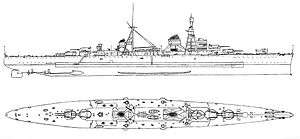Trento-class cruiser
 Trento | |
| Class overview | |
|---|---|
| Builders: | Trento Cantiere navale fratelli Orlando, Livorno |
| Operators: |
|
| Succeeded by: | Zara class |
| In commission: | 1926 |
| Completed: | 3 |
| Lost: | 3 |
| General characteristics | |
| Type: | Heavy cruiser |
| Displacement: |
|
| Length: | 196.9 m (646 ft 0 in) |
| Beam: | 20.6 m (67 ft 7 in) |
| Draught: | 6.7 m (22 ft 0 in) |
| Propulsion: |
|
| Speed: | 36 kn (67 km/h; 41 mph) |
| Range: | 4,160 nautical miles (7,700 km) at 16 knots (30 km/h) |
| Complement: | 723 |
| Armament: |
|
| Armour: |
|
| Aircraft carried: | 3 reconnaissance |
The Trento class was an Italian heavy cruiser design of the Regia Marina from the late 1920s. The two ships in the class were named after unredeemed cities taken from the Austro-Hungarian empire after the victory in World War I: Trento and Trieste.
Design
The Trentos were the first ships nominally designed to the limitations of the Washington Naval Treaty. This limited cruisers to 10,000 tons and 8-inch (203 mm) guns, a limitation that made firepower, speed and protection difficult to build into a single design. A particular problem faced by the Italian designers was that their ships had to be able to protect the lengthy Italian coastline from widely separated naval bases, meaning that high speed was a key feature. In the end they chose to sacrifice armor and fuel storage, and thus range, in order to attain the required speed and weight while still being armed with the latest 8-inch guns.
Trento started construction in 1925 along with her sister ship, Trieste. Trieste was launched first in 1926 and commissioned in 1928, while Trento followed in 1927 and 1929 respectively. A third, Bolzano, started construction in 1930 and was commissioned in 1933; though the Bolzano was quite different from the other two vessels, she is sometimes considered member of the Trento class. It was later concluded that the tradeoff in armour put the ships at a disadvantage, and an up-armored version of the design was produced as the highly rated Zara class in the early 1930s.
Ships in class
Trieste
Trieste served as the flagship of the 3rd Division. In 1940, she participated in the battle of Cape Spartivento. At Spartivento, the three cruisers of the class fired on their British counterparts from a range of 21,500 yards (19,700 m), and it is believed that either Trieste or Trento hit the heavy cruiser HMS Berwick at least once and straddled HMS Manchester.[1] Still pending repairs, additional damage in the course of a battle with the German cruiser Admiral Hipper in the Atlantic on Christmas Day put Berwick out of action for six months.[2]
On 21 November 1941 she was hit by a torpedo from the submarine HMS Utmost, and although badly damaged, she was able to reach base at Messina with difficulty. She remained out of action until mid-1942, when she rejoined the fleet. On 10 April 1943, she sank after being hit by several bombs dropped by USAAF B-24s while in port at La Maddalena, Sardinia. After the war, she was sold to Spain in 1951, being raised and moved to Ferrol in anticipation of being converted into an aircraft carrier, but a change in leadership of the Spanish Navy saw the project being dropped, and the cruiser was scrapped.[3]
Trento
In June 1929, Trento began a cruise to South America which extended until 10 October 1929. In February 1932 Trento was sent to Tianjin, China, to join the San Marco Battalion as a show of force during the Second Sino-Japanese War, returning on 30 June. In August 1933, Trento joined Trieste and newly commissioned Bolzano to become the Second Naval Division. In 1934 the Regia Marina was re-organized, and the three ships became the Third Naval Division.
During the Spanish Civil War the division carried out escort missions in the western Mediterranean Sea.
During World War II, Trento took part in most major Italian operations, including the battles of Calabria, Cape Spartivento, and Cape Matapan.
On the morning of 15 June 1942 Trento was navigating in a battle fleet to prevent a large Allied convoy from reaching Malta (Operation Vigorous), and was attacked and sunk after being torpedoed twice. The first hit was inflicted by a Malta-based Bristol Beaufort bomber at 5:15am.This plane was flown by f/o Arthur Aldridge and his crew. This operation was later recalled in his book 'The Last Torpedo Flyers' published in 2013. Trento was immobilized and left behind, assisted by the destroyer Da Verrazzano, while the rest of the fleet continued south in pursuit of the Vigorous convoy. The Royal Navy submarine HMS Umbra found the smoking ship at 9:10am, and torpedoed her, hitting the magazine, sinking Trento rapidly (9:15am). Crew members had little time to put on life vests and abandon ship. Over half the crew died from the explosions, went down with the ship or were killed when Italian escort ships dropped depth charges to stop the submarine. Trento still lies at the bottom of the Ionian Sea, where the Mediterranean is at its deepest, at the position 36°10′N 18°40′E / 36.167°N 18.667°E.
References
- ↑ Greene, Jack & Massignani, Alessandro (1998). The Naval War in the Mediterranean, 1940-1943, Chatam Publishing, London, pp. 119-121. ISBN 1-86176-057-4
- ↑ Navy, corporateName=Royal Australian. "H.M. Ships Damaged or Sunk by Enemy Action in WWII". www.navy.gov.au. Retrieved 2015-12-21.
- ↑ Busquets i Vilanova, Camil, Albert Campanera, and Juan Luis Coello Lillo. Los Portaviones Españoles. (Spanish) Aldaba, 1994. ISBN 84-88959-02-8.
External links
- Trento, from official Marina Militare web site.